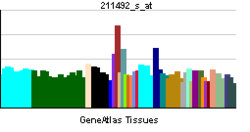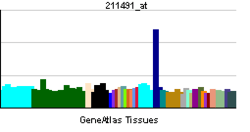Alpha-1A adrenergic receptor
The alpha-1A adrenergic receptor (α1A adrenoreceptor), also known as ADRA1A, formerly known as the alpha-1C adrenergic receptor,[1] is an alpha-1 adrenergic receptor, and also denotes the human gene encoding it.[2]
Receptor
There are 3 alpha-1 adrenergic receptor subtypes: alpha-1A, -1B and -1D, all of which signal through the Gq/11 family of G-proteins. Different subtypes show different patterns of activation. The majority of alpha-1 receptors are directed toward the function of epinephrine, a hormone that has to do with the fight-or-flight response.
Gene
This gene encodes the alpha-1A-adrenergic receptor. Alternative splicing of this gene generates four transcript variants, which encode four different isoforms with distinct C-termini but having similar ligand binding properties.[2]
Ligands
Agonists
- 6-(5-fluoro-2-pyrimidin-5-yl-phenyl)-6,7-dihydro-5H-pyrrolo[1,2-a]imidazole: EC50 = 1nM, Emax = 65%; good selectivity over α1B, α1D and α2A subtypes[3]
- further partial agonistic imidazole compounds[4][5]
- A-61603[6]
Antagonists
- Tamsulosin: for treatment of benign prostatic hyperplasia
- Silodosin: for treatment of benign prostatic hyperplasia
- Risperidone
- WB-4101
- Ziprasidone
Role in neural circuits
α1A-adrenergic receptor subtypes increase inhibition at dendrodendritic synapses, suggesting a synaptic mechanism for noradrenergic modulation of olfactory driven behaviors.[7]
See also
References
- ↑ Langer SZ (1998). "Nomenclature and state of the art on alpha1-adrenoceptors". Eur. Urol. 33 Suppl 2: 2–6. doi:10.1159/000052227. PMID 9556189.
- 1 2 "Entrez Gene: ADRA1A adrenergic, alpha-1A-, receptor".
- ↑ Roberts LR, Fish PV, Ian Storer R, Whitlock GA (April 2009). "6,7-Dihydro-5H-pyrrolo[1,2-a] imidazoles as potent and selective alpha(1A) adrenoceptor partial agonists". Bioorg. Med. Chem. Lett. 19 (11): 3113–7. doi:10.1016/j.bmcl.2009.03.166. PMID 19414260.
- ↑ Whitlock GA, Brennan PE, Roberts LR, Stobie A (April 2009). "Potent and selective alpha(1A) adrenoceptor partial agonists-Novel imidazole frameworks". Bioorg. Med. Chem. Lett. 19 (11): 3118–21. doi:10.1016/j.bmcl.2009.03.162. PMID 19394220.
- ↑ Roberts LR, Bryans J, Conlon K, McMurray G, Stobie A, Whitlock GA (December 2008). "Novel 2-imidazoles as potent, selective and CNS penetrant alpha1A adrenoceptor partial agonists". Bioorg. Med. Chem. Lett. 18 (24): 6437–40. doi:10.1016/j.bmcl.2008.10.066. PMID 18980842.
- ↑ Knepper SM, Buckner SA, Brune ME, DeBernardis JF, Meyer MD, Hancock AA (1995). "A-61603, a potent alpha 1-adrenergic receptor agonist, selective for the alpha 1A receptor subtype". J. Pharmacol. Exp. Ther. 274 (1): 97–103. PMID 7616455.
- ↑ Zimnik NC, Treadway T, Smith RS, Araneda RC (2013). "α(1A)-Adrenergic regulation of inhibition in the olfactory bulb". J. Physiol. (Lond.) 591 (Pt 7): 1631–43. doi:10.1113/jphysiol.2012.248591. PMC 3624843. PMID 23266935.
External links
- "α1A-adrenoceptor". IUPHAR Database of Receptors and Ion Channels. International Union of Basic and Clinical Pharmacology.
Further reading
- Mátyus P, Horváth K (1998). "Alpha-adrenergic approach in the medical management of benign prostatic hyperplasia". Med Res Rev 17 (6): 523–35. doi:10.1002/(SICI)1098-1128(199711)17:6<523::AID-MED2>3.0.CO;2-3. PMID 9359081.
- Hoehe MR, Berrettini WH, Schwinn DA, Hsieh WT (1993). "A two-allele PstI RFLP for the alpha-1C adrenergic receptor gene (ADRA1C)". Hum. Mol. Genet. 1 (5): 349. doi:10.1093/hmg/1.5.349-a. PMID 1363873.
- Schwinn DA, Lomasney JW, Lorenz W; et al. (1990). "Molecular cloning and expression of the cDNA for a novel alpha 1-adrenergic receptor subtype". J. Biol. Chem. 265 (14): 8183–9. PMID 1970822.
- Hirasawa A, Shibata K, Horie K; et al. (1995). "Cloning, functional expression and tissue distribution of human alpha 1c-adrenoceptor splice variants". FEBS Lett. 363 (3): 256–60. doi:10.1016/0014-5793(95)00330-C. PMID 7737411.
- Diehl NL, Shreeve SM (1995). "Identification of the alpha 1c-adrenoceptor in rabbit arteries and the human saphenous vein using the polymerase chain reaction". Eur. J. Pharmacol. 268 (3): 393–8. doi:10.1016/0922-4106(94)90064-7. PMID 7805763.
- Schwinn DA, Johnston GI, Page SO; et al. (1995). "Cloning and pharmacological characterization of human alpha-1 adrenergic receptors: sequence corrections and direct comparison with other species homologues". J. Pharmacol. Exp. Ther. 272 (1): 134–42. PMID 7815325.
- Weinberg DH, Trivedi P, Tan CP; et al. (1994). "Cloning, expression and characterization of human alpha adrenergic receptors alpha 1a, alpha 1b and alpha 1c". Biochem. Biophys. Res. Commun. 201 (3): 1296–304. doi:10.1006/bbrc.1994.1845. PMID 8024574.
- Forray C, Bard JA, Wetzel JM; et al. (1994). "The alpha 1-adrenergic receptor that mediates smooth muscle contraction in human prostate has the pharmacological properties of the cloned human alpha 1c subtype". Mol. Pharmacol. 45 (4): 703–8. PMID 8183249.
- Hirasawa A, Horie K, Tanaka T; et al. (1993). "Cloning, functional expression and tissue distribution of human cDNA for the alpha 1C-adrenergic receptor". Biochem. Biophys. Res. Commun. 195 (2): 902–9. doi:10.1006/bbrc.1993.2130. PMID 8396931.
- Tseng-Crank J, Kost T, Goetz A; et al. (1996). "The alpha 1C-adrenoceptor in human prostate: cloning, functional expression, and localization to specific prostatic cell types". Br. J. Pharmacol. 115 (8): 1475–85. doi:10.1111/j.1476-5381.1995.tb16640.x. PMC 1908895. PMID 8564208.
- Shibata K, Hirasawa A, Moriyama N; et al. (1997). "Alpha 1a-adrenoceptor polymorphism: pharmacological characterization and association with benign prostatic hypertrophy". Br. J. Pharmacol. 118 (6): 1403–8. doi:10.1111/j.1476-5381.1996.tb15552.x. PMC 1909672. PMID 8832064.
- Chang DJ, Chang TK, Yamanishi SS; et al. (1998). "Molecular cloning, genomic characterization and expression of novel human alpha1A-adrenoceptor isoforms". FEBS Lett. 422 (2): 279–83. doi:10.1016/S0014-5793(98)00024-6. PMID 9490024.
- Daniels DV, Gever JR, Jasper JR; et al. (1999). "Human cloned alpha1A-adrenoceptor isoforms display alpha1L-adrenoceptor pharmacology in functional studies". Eur. J. Pharmacol. 370 (3): 337–43. doi:10.1016/S0014-2999(99)00154-5. PMID 10334511.
- Cogé F, Guenin SP, Renouard-Try A; et al. (1999). "Truncated isoforms inhibit 3Hprazosin binding and cellular trafficking of native human alpha1A-adrenoceptors". Biochem. J. 343 Pt 1 (Pt 1): 231–9. doi:10.1042/0264-6021:3430231. PMC 1220546. PMID 10493934.
- Rudner XL, Berkowitz DE, Booth JV; et al. (1999). "Subtype specific regulation of human vascular alpha(1)-adrenergic receptors by vessel bed and age". Circulation 100 (23): 2336–43. doi:10.1161/01.cir.100.23.2336. PMID 10587338.
- Ballou LM, Cross ME, Huang S; et al. (2000). "Differential regulation of the phosphatidylinositol 3-kinase/Akt and p70 S6 kinase pathways by the alpha(1A)-adrenergic receptor in rat-1 fibroblasts". J. Biol. Chem. 275 (7): 4803–9. doi:10.1074/jbc.275.7.4803. PMID 10671514.
- Keffel S, Alexandrov A, Goepel M, Michel MC (2000). "alpha(1)-adrenoceptor subtypes differentially couple to growth promotion and inhibition in Chinese hamster ovary cells". Biochem. Biophys. Res. Commun. 272 (3): 906–11. doi:10.1006/bbrc.2000.2850. PMID 10860850.
- Richman JG, Brady AE, Wang Q; et al. (2001). "Agonist-regulated Interaction between alpha2-adrenergic receptors and spinophilin". J. Biol. Chem. 276 (18): 15003–8. doi:10.1074/jbc.M011679200. PMID 11154706.
- Shibata K, Katsuma S, Koshimizu T; et al. (2003). "alpha 1-Adrenergic receptor subtypes differentially control the cell cycle of transfected CHO cells through a cAMP-dependent mechanism involving p27Kip1". J. Biol. Chem. 278 (1): 672–8. doi:10.1074/jbc.M201375200. PMID 12409310.
| ||||||||||||||||||||||||||||||||||||||||||||||||||||||||||||||||||||||||||||||||||||||||||||||||||||||||||||||


